- Series vs Parallel:
- There are 2 ways to connect
multiple devices to a power source (e.g. speakers
to an amplifier), series and parallel. Well...
OK, there's also series/parallel. But we'll cover
that on a later
section.
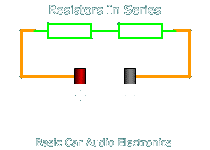
Speakers in
series
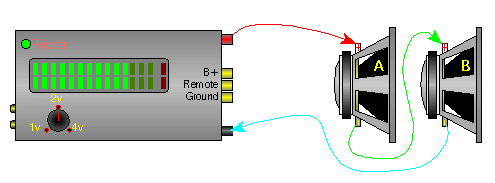
- In a series circuit (like the
two above), the current must flow through one
device to get to the next device. This means that
the rate of current flow
through all devices is the same. The voltage across each device
depends on its impedance/resistance of each
device and the current flowing through the
circuit. When adding more components in a series
circuit, the current flow decreases, if the
applied voltage remains constant.
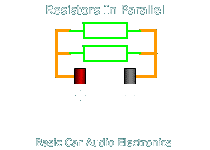
Speakers in
parallel
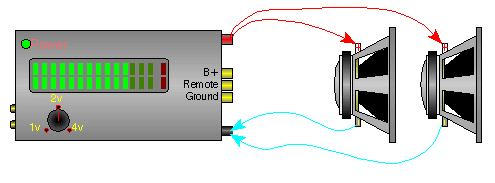
- In a parallel circuit (like the
two examples above), each device is directly
connected to the power source. This means that each device receives the same voltage. The amount of current flowing
through each device is dependent on the
impedance/resistance of that particular device.
If devices are added to the power source in a
parallel configuration, the current demand/flow
from the power source increases.
- In the 2 diagrams below, you
can see the relationship between the current flow
out of the amplifier and the number of speakers.
You can see that four speakers draws twice as
much current from the amplifier than the two
speaker configuration.
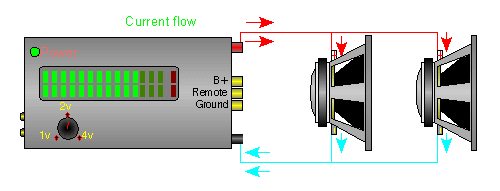
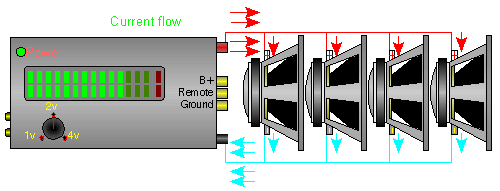
- When making any connections to
any power source you must know the limits of the
source, to prevent damage to the source. This
means that if you connect too many speakers, in a
parallel wiring configuration, to an amplifier
(the power source in this case) it may well be
damaged beyond repair. I've seen it happen,
especially when the amplifier was improperly
fused.
For
those Who Want to do the Math...
- In the diagrams/text above, we
had either series OR parallel circuits. This
section will show you what happens to the
voltage, current and power dissipation in a
series/parallel circuit. As was said before, in a
series circuit, the 'current' in each device is
the same. In a parallel circuit, the 'voltage' is
the same across each device. In the following
circuit, you can see that there are two 1000 ohm
resistors in series with a single 400 ohm
resistor. We know that the voltage across the two
1000 ohm resistors is going to be the same
(because they're connected in parallel). We also
know that the total current flow through the two
parallel connected resistors will equal the
current flow through the 400 ohm resistor.
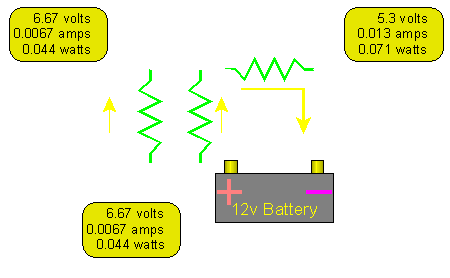
- To calculate the total current,
we should first simplify the circuit. This means
we need to find the total resistance of the
parallel network. For a simple circuit with two
equal value resistors, we can simply divide the
resistance of a single component by the total
number of components. For this parallel network,
we have two 1000 ohm resistors. If we had 3
parallel resistors, we'd divide 1000 by 3 to find
the total resistance of the parallel resistors.
- Total
resistance of parallel resistors = resistance of
a single component/number of resistors
- Total
resistance of parallel resistors = 1000/2
- Total
resistance of parallel resistors = 500 ohms
-
- Now that we know that the
parallel resistors are equal to a single 500 ohm
resistor. Now that we have, esentially, one 500
ohm resistor in series with a 400 ohm resistor,
we can calculate the total current through the
circuit. We know that we have a 12 volt power
source. We also know that the 500 ohm resistor in
series with the 400 ohm resistor is equal to a
900 ohm resistor.
- Current
flow through circuit = voltage across
circuit/total circuit resistance
- Current
flow through circuit = 12/900
- Current
flow through circuit = 0.0133 amps
-
- Now we can find the voltage
across the individual components. To reduce the
possibility of getting confused, calculate the
voltage across the single resistor first.
- Voltage
across the resistor = resistor's
resistance*current flow through resistor
- Voltage
across the resistor = 400*0.0133
- Voltage
across the resistor = 5.333 volts
-
- In a series circuit, all of the
voltages across all of the individual series
components will equal the power supply voltage.
If we have a 12 volt source and the voltage
across the 400 ohm resistor is 5.333 volts, we
know that the voltage across the parallel pair of
resistors is going to be 6.67 volts
(12-5.333=6.67). To calculate the current through
the parallel components...
- Current
through a single 1000 ohm resistor = voltage
across resistor/resistance
- Current
through a single 1000 ohm resistor = 6.67/1000
- Current
through a single 1000 ohm resistor = .0067 amps
-
- Now that we know the voltage across
each of the components and the current flow through
each of the components, we can calculate the
power dissipation for each component. Actually we
could have done it as soon as we knew the voltage
across the components but I decided to take the
'scenic' route.
- Power
dissipation in the 400 ohm resistor = voltage
across component*current through component
- Power
dissipation in the 400 ohm resistor = 5.33*0.013
- Power
dissipation in the 400 ohm resistor = 0.071 watts
-
- Power
dissipation in each 1000 ohm resistor = voltage
across component*current through component
- Power
dissipation in each 1000 ohm resistor =
6.67*.0067
- Power
dissipation in each 1000 ohm resistor = .045
watts
-
- This example used resistors but
the same calculations would work for any
resistive device. Although speakers are not
purely resistive when being driven with AC
voltage, the calculations here could be used to
make rough calculations for voltage, current and
power dissipation in speakers.
|